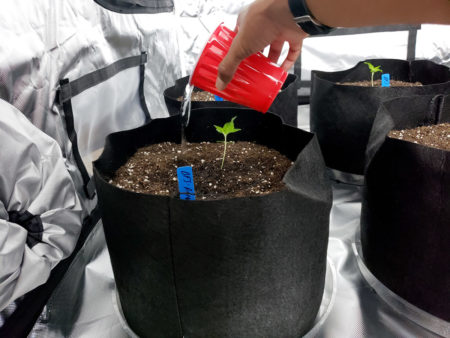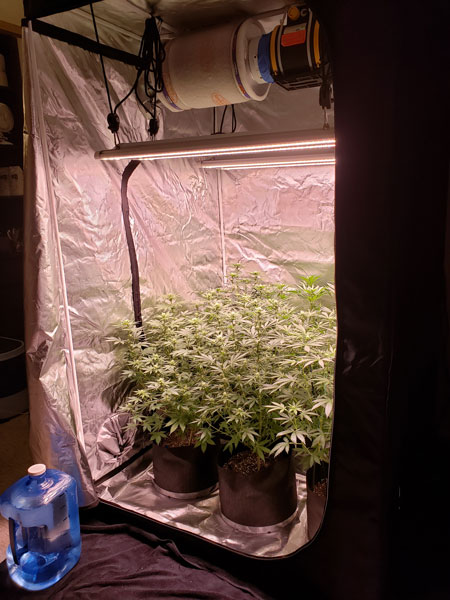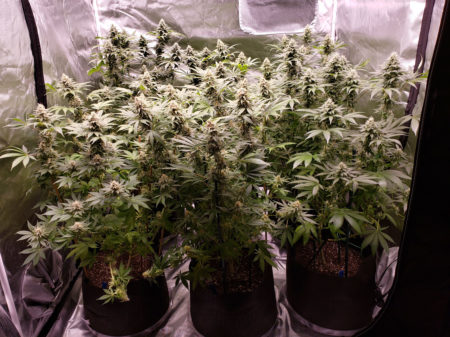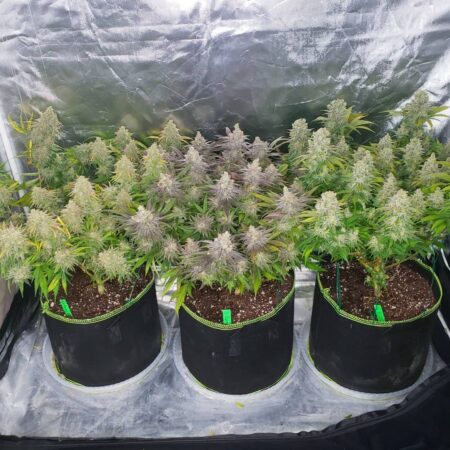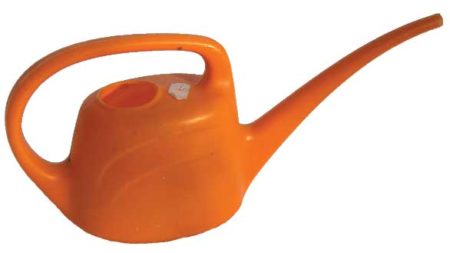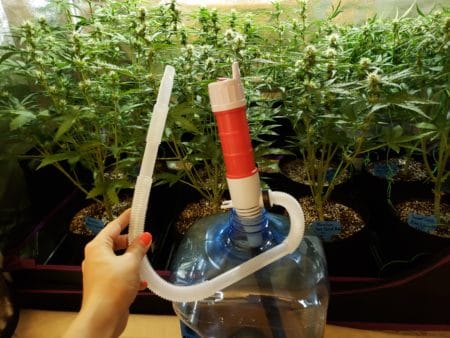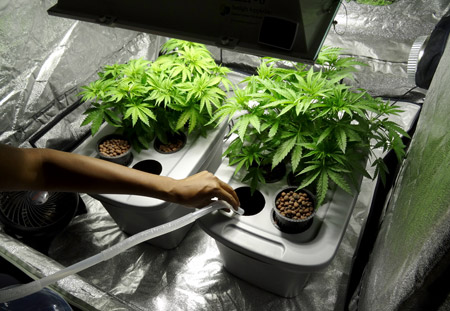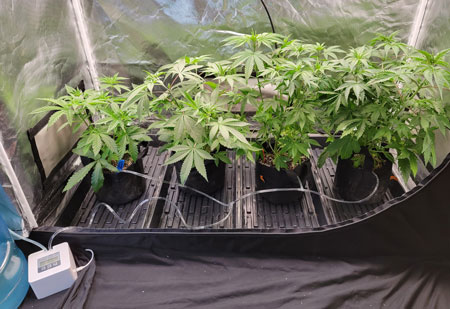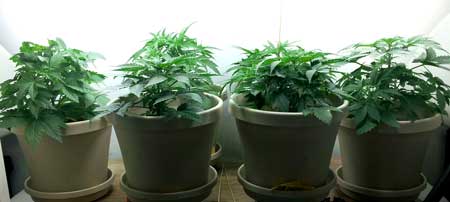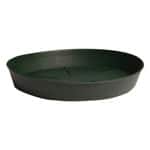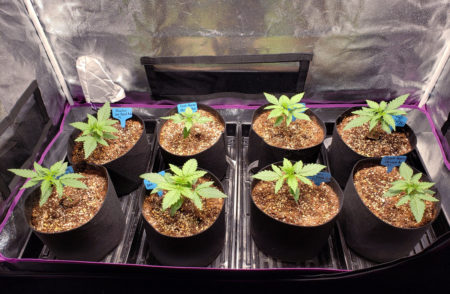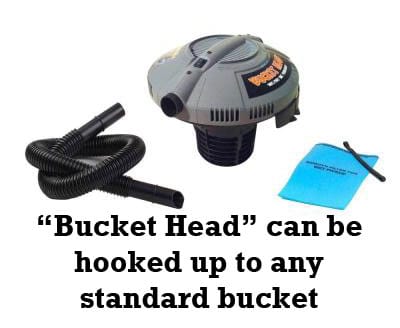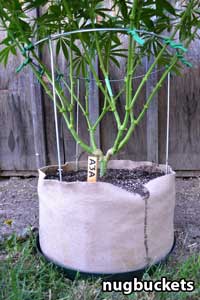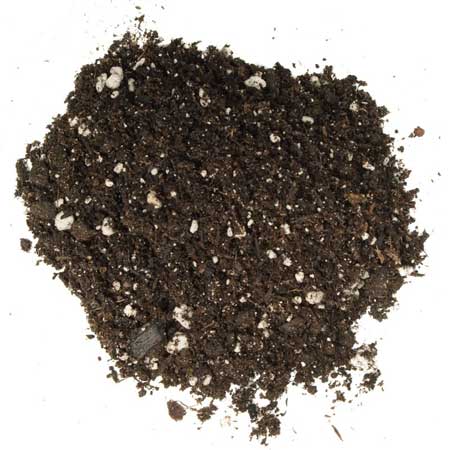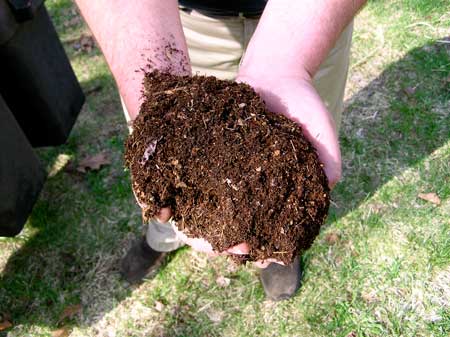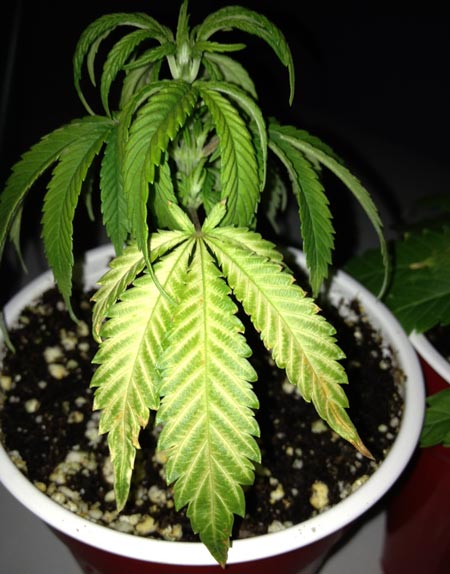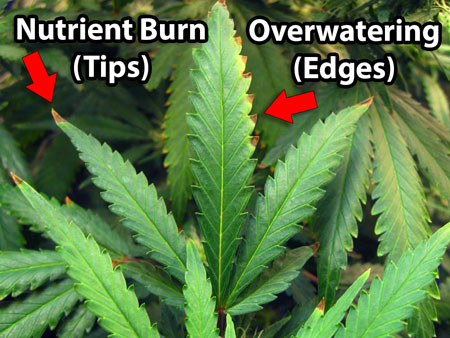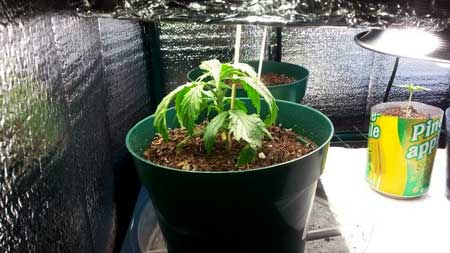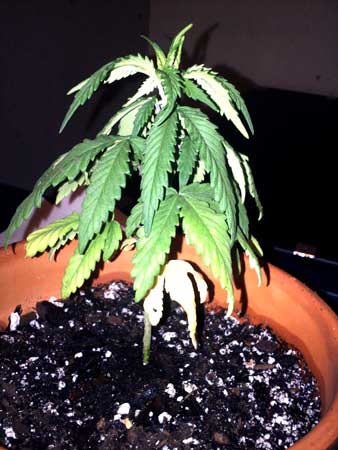by Nebula Haze
Quick Answer: Water plants when the soil feels dry up to your first knuckle (or if the pot feels light).
That’s the short quick answer. If you do that, you’ll typically have great results. However, read the rest of this tutorial for more details and pictures.
Try to water plants properly to get fast-growing cannabis seedlings and adult plants.
Keeping plants watered properly helps them move nutrients through the plant. Proper watering helps prevent nutrient deficiencies and also lets cannabis plants be closer to grow lights without light stress, resulting in your plants being able to make more energy from light. Altogether, this means watering cannabis properly makes them grow faster and produce bigger buds.
Today’s cannabis watering tutorial will teach you exactly how much water to give plants, and when. It’s really simple to water plants right when you have the right information.
How to water cannabis plants in soil
Here are directions on how to water marijuana plants in soil. First I’ll share some tips for seedlings, and then tips for older plants that are already established.
How to water cannabis seedlings in soil
We have a complete “how to water” tutorial but check out this example schedule for watering seedlings in 5-gallon fabric pot.
- Day 1 – Give 2 cups (500ml) water per seedling
- Day 3 – Give 2 cups (500ml) water per seedling
- Day 6 – Give 2 cups (500ml) water per seedling
- Day 8 – Give 3 cups (750ml) water per seedling (every 3 days after this)
- Day 11 – Give 3 cups (750ml) water per plant
- Day 14 – Give 4 cups (1 liter) water per plant
- Day 17 – Give 4 cups (1 liter) water per plant
- Day 20 – Give 5 cups (1.25 liter) water per plant
- Day 23 – Give 6 cups (1.5 liter) water per plant
- Day 26 – Give 6 cups (1.5 liter) water per plant
- Day 29 – Give 8 cups or 1/2 gallon (2 liter) water per plant
- Continue giving 1/2 gallon (2 liters) per plant every 3 days. You may need to give more at a time or more often as plants get bigger. If you’re getting a lot of runoff out the bottom (more than 20%) or plants droop after watering, it means you should be giving less water at a time. If plants get droopy before being watered, you should give more water at a time, or water more often.
Note: This is the schedule that I use for a 5-gallon fabric pot, but your environment will affect how much plants drink. If plants are in hard-sided pots as opposed to fabric pots, you may need to water less often or give less water at a time.
Learn more about how to care for cannabis seedlings
How to water cannabis vegetative and flowering plants in soil
It’s a 3-step process to water vegetative or flowering cannabis plants.
- When to water: Wait until the topsoil feels dry about an inch deep (up to your first knuckle – just use your finger to poke a hole in the soil and see if it feels dry). Another option is to pick up the pot to see how heavy it feels. When a plant is well-watered, the plant pot will feel heavy. When the plant has drank all the water, the pot becomes surprisingly light.
- How much water to give:
- If using nutrients: If you regularly add cannabis-friendly made-for-soil nutrients in the water, give enough water that you get about 10% extra runoff water from the bottom of your pot. Just add a little at a time nutrient water until you get an idea of how much water that ends up taking. Getting 10% runoff water coming out the bottom prevents nutrient buildup in the potting mixture. Otherwise, you are continuously adding more nutrients to the system. Make sure to remove runoff water instead of letting plant pots sit in it.
- If not using nutrients: If you’re growing in properly amended soil like “just add water” super soil, you want to avoid getting any runoff as this will wash away precious nutrients in the water that you’re trying to save for the plant. Try to give just enough water to fill the pot all the way to the bottom but only get a drop or two of runoff at most. Just add a little bit of water at a time until you figure out the proper amount for your plants and setup.
- When to water again: Go back to step 1 and wait until the topsoil feels dry again (or the pot feels light).
Here are some tips and answers to common questions about watering cannabis plants in soil.
Why is soil taking a long time to dry out?
It’s good to aim to water every 2-3 days in soil. If pots take a long time (4-5+ days) to dry out before the next watering, you may need to give less water at a time until plants are bigger and drinking more. Soil taking a long time to dry out is especially common in a cool grow room. Plants tend to grow faster and drink a lot more water when they’re warm. Another reason soil might take a long time is some kind of problem with drainage, for example if there are no holes to let water out the bottom, or if soil is thick and muddy instead of fluffy and airy. What’s good soil for growing cannabis? If your cannabis plants are small compared to the size of their container, give water sparingly until plants get bigger.
What’s the easiest way to water cannabis plants in soil?
When I first started growing, I gave my plants water using a watering can. A watering can works great, but it’s hard to water a bunch of plants with one watering can because you have to keep filling it up.
An old-fashioned watering can gets the job done, but they typically don’t hold a lot of water at a time, which is inconvenient if you’re growing a lot of plants
I personally like using a Battery Operated Liquid Transfer Pump to water the plants. You can pump water from a bigger container to your plants. This is a 3-gallon water container from Wal-Mart, and the pump just reaches the bottom. My grow tent is 2 feet deep and this reaches the plants in the back. However, I don’t think the tube is long enough to reach the back if your space is deeper than that.
This water transfer pump can reach into a shallow grow space to water all your plants more easily.
If you’ve got a deeper tent or grow space (like a 3’x3′ or 4’x4′), you want a pump with a longer tube to reach all the cannabis plants in the back.
Another option is to set up a drip feed system to pump water directly to plants. This can be a great choice if you have a lot of plants you can’t easily reach.
Learn more about automatic watering with pumps.
Automated watering systems can be helpful in many situations.
Let us know if there’s something we missed. Growers get creative!
What’s the best way to collect runoff water?
It’s important to keep plants on saucers or trays so you can remove the runoff water instead of letting roots sit in the water and get “wet feet”. “Wet feet” just means that the roots are staying wet too long. This prevents nutrients from moving freely through the plant. Stems or roots may rot. Fungus gnats come to fest on the fungus that grows in too-wet soil. When using plant saucers, you can collect the saucers one by one and dump them out, but that gets inconvenient with many plants.
It’s inconvenient to empty saucers one by one if you have a bunch of plants, but you don’t want to leave plants sitting in runoff water. So what do you do?
A plant saucer catches water but should be emptied.
One idea: Use trays on an incline so runoff water pools to the front.
If you put your plant on plastic trays, and then put the trays on a slight incline by putting something small underneath in the back, it will cause all the runoff water to drain to the front for easy collection. The item in the back only needs to be about half an inch (or even less) thick, for example, a piece of plywood, a bottle cap, etc. If you can find something more water-resistant, like plastic, that’s your best option to prevent the chance of anything growing.
These 1’x2′ plastic plant trays work well if they fit your space. You can fit four of them in a 2’x4′ grow tent (this is the grow tent I use) with up to two plants each as long as your plant containers are 11″ wide or smaller at the base.
Put trays on a slight incline by placing something underneath the tray in the back. This causes all the water to come to the front for easier collection. Each of these trays has a small plastic board (which we found around the house from something else) under the back. Anything that’s about half an inch high will do the trick. These particular trays accommodate plant containers up to 11″ wide at the base.
Put trays on an incline
Not sure how to remove runoff water after watering your marijuana? Wet vacuums can be a great choice, especially if you already have one in the house. I didn’t have one, so I got Bucket Head attachment which can turn any standard 5-gallon bucket into a wet vac. You can buy one online but it’s $10-15 cheaper if you get it in person at a Home Depot. A downside to the Bucket Head and all wet vaccuums are they’re loud, just like most wet vacs.
A wet vacuum like the Bucket head style wet vacs can be used to collect the water when combined with a 5-gallon bucket.
Learn more about how to remove runoff water
Make Sure Pots Have Good Drainage
It’s very important to make sure that water can drain freely from the bottom of the pot, otherwise, the plant can get waterlogged and become overwatered (causing the plant to droop).
In addition to making sure the actual container has drainage (holes on the bottom, or some other way for extra water to escape), it’s also important to make sure your growing medium drains freely. If it takes several minutes for the water to come out the bottom of your pot when you water, it means that there isn’t enough drainage in the actual growing medium (it’s too dense, so water is having a hard time getting through).
Example of great cannabis soil
How to improve the drainage of your growing medium
- Never use dirt you find outside. Chances are it does not have the correct properties for vigorous cannabis growth.
- Use an organic potting mix – It’s not necessarily the fact that it’s organic but that organic potting mixes are typically high quality with a fluffy quality that cannabis plants love.
- If you’re willing to invest a little extra money, get a cannabis-specific soil like Fox Farm Ocean Forest, which is a rich soil full of nutrients and cannabis plants grow well in it.
- Looking for “just add water” soil? Learn more here.
- Mix in extra perlite to loosen the soil and allow water to drain through more easily.
- Bark or wood chips are not the best choice for growing cannabis plants, even though they’re sometimes recommended to improve drainage in soil for some types of plants. It may not be possible, but try to avoid using soil that contains bark or wood chips. What makes soil good or bad for growing cannabis?
- Use fabric pots – fabric pots (or any pots that let in from the sides) help get oxygen to your roots, which gives you faster growth. Fabric pots also make it harder to overwater your plants. A cannabis plant growing in a tan fabric smart pot is pictured to the right.
This is an example of great soil for growing for cannabis – rich, composted, and well-draining Even better if you add 20% perlite (airy white rocks) to increase the fluffiness and amount of air that gets held in the soil.
What are examples of good soil for cannabis?
What do I do if cannabis plants are drooping?
If your cannabis plants show signs of drooping, often the plant is getting too much or too little water, but not always. Drooping can be caused by….
Overwatering
- Giving too much water at a time
- Giving water too often
Learn more about overwatering.
Underwatering
- Not giving enough water at a time
- Giving water too infrequently
Learn more about underwatering.
Other reasons for drooping cannabis plants
- Too hot – Drooping can occur in hot conditions. Learn how to deal with heat.
- Too cold – If it gets cool (under 65°F/18°C), plants may droop. They’re also more prone to overwatering. What’s the best cannabis light for a cold grow room?
- Humidity – If it’s too humid or dry, the plant isn’t able to move water properly through the plant, causing drooping. Aim for about 50% humidity (40-60% is fine). But if it’s super dry or really wet in there, take steps to fix the humidity. Dry air is especially hard on plants if it’s hot. Humid/wet air is harder on plants that are cool
- Right after watering for plants that were underwatered – Plants sometimes get even more droopy if they are given a lot of water after being allowed to dry out for too long. This is due to the stress of the water pressure quickly changing at the roots. Give them some time.
- Root problems – If a plant develops unhealthy roots (root rot in hydro, or as the result of chronic overwatering/heat/other stressors on this list), they will droop even if you’re giving the right amount of water and good conditions. When a plant has root problems, it typically takes them some time to recover. In rare cases, plants may not be able to come back, but usually plants recover if you just take great care of them for a while.
- Leaves go down right before grow lights go out – Plants put their leaves down a bit during their “night”, and you’ll notice the leaves actually start getting a little droopy right before lights go out. That can sometimes be mistaken as drooping when its actually part of the plant’s natural rhythm. If plants look fine during the rest of the day, this is totally normal.
Signs of Overwatering/Underwatering
Droopiness is the main sign. Here are examples of leaf symptoms that also commonly appear when plants are over-watered vs under-watered.
This seedling is droopy and getting nutrient deficiencies due to overwatering
Sometimes brown edges can be mistaken for nutrient burn. If you’re seeing the edges turn brown, that may be a sign of overwatering, especially if combined with droopiness.
Example of an underwatered plant. Underwatering is very similar in appearance to overwatering. The main clue is the plant is getting droopy before being watered (not after).
If you’re seeing droopiness, it almost always means there’s some sort of issue with the roots or watering
How do I avoid nutrient deficiencies?
Nutrient deficiencies can be really hard to pin down at a times. It often has to do with watering habits (and occasionally your environment).
5 ways to prevent nutrient deficiencies:
- Avoid over/under watering (this is surprisingly the most common reason for nutrient deficiencies in younger plants)
- Give the right nutrients for grow medium (don’t give soil-specific nutrients to plants in hydroponics, etc.)
- Check the root pH if you notice spots or discoloration on your leaves
- Be aware of light burn, which is often confused for a deficiency
- Use the free plant doctor tool whenever you’re stuck!
What do nutrient deficiencies look like on cannabis leaves?
Use our cannabis plant doctor to diagnose sick plants!

